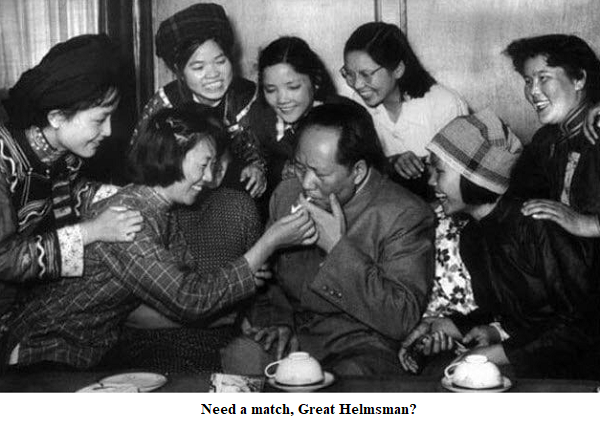
Some time ago in these pages, I treated you to a slightly salacious account of the amatory exploits or lack thereof of Chiang Kai-shek. So it seems reasonable to give Chairman Mao the same treatment. And I have to say that in both cases this is justified not only by salacious curiosity, but by the fact that both Mao and Chiang had wives who had important political roles: in Chiang’s case we are talking of Mayling Soong, one of the greatest women of the twentieth century; in Mao’s of Jiang Qing, who wielded influence quite out of proportion to either her official political position or her personal capabilities. Power is the greatest aphrodisiac and Chairman Mao had lots of that. But beyond that, their choices in women and their treatment of their partners speak volumes about their characters. In Mao’s case, he was clearly attracted to forceful intelligent women (although where Jiang Qing fits into this analysis is unclear). His treatment of them is almost universally driven by brutal self-interest.
Like most village people in China, Mao had an arranged village wife. The wedding happened in 1908 when he was fourteen and she was twenty. We don’t know much about her, even her name. Family chronicles in China record only the surnames of wives—hers was Luo. His first experience of marriage didn’t make Mao a fan of arranged marriages, which he later described as “indirect rape”. In his 1937 conversations with the American journalist Edgar Snow, Mao said, “I never lived with her … I do not consider her my wife.” In fact, by 1937 she had been long dead. Mao family chronicles report that she died only two years after the wedding, when Mao was sixteen.
This essay appears in the latest Quadrant.
Click here to subscribe
It is interesting to compare Mao’s village marriage with Chiang Kai-shek’s. Although Chiang also was a revolutionary, he retained enough of the Confucian ethic to honour his mother throughout his life, and whatever his later liaisons, his village wife continued to live with his mother until they were both killed in a Japanese air raid. Indeed, when his second marriage forced him to put away his concubine of the time, she and his adopted son went to live with Chiang’s mother and his village wife. Contrast this with Mao. He loved his mother but he hated and despised his father, and rejected the Confucian ethic. Of course, his wife’s early death makes this entirely speculative, but one suspects that if she had survived, Mao’s village wife would have been abandoned and forgotten, as were others later.
For several years after that, although Mao was young and fit, we see little evidence of romantic liaisons. Indeed Mao, discussing the society in which he travelled between 1915 and 1918, told Edgar Snow:
They had little time for love or “romance” and considered the times too critical and the need for knowledge too urgent to discuss women or personal matters … Quite aside from the discussions of feminine charm which usually play an important part in the lives of young men of this age, my companions even rejected talk of ordinary matters of daily life.
Love first came into Mao’s life via one of the greatest influences on his life, his professor of ethics at Hunan First Normal School, and later the man who got him a job at Peking University, Yang Changji. Mao’s friend and fellow student at the Normal School, Emi Siao, described Yang as “a very learned person … endowed with a strong personality with which he enforced upon himself a very strict moral code. His conduct was at all times 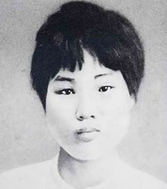 beyond reproach.”
beyond reproach.”
Yang kept an open house at his house in Changsha for his students, who ate there every Sunday, and it was there that Mao first met Yang’s daughter, Yang Kaihui (right). Emi Siao described her as “rather small in stature and round faced. She looked somewhat like her father with the same deep-set smallish eyes, but her skin was quite white.” Emi Siao says that when Mao first met her in 1912, she was seventeen. Others say she was much younger than that. Yang’s strict adherence to the Confucian code of behaviour meant that there was little chance of flirtation at these meals. Smiling and laughing were discouraged and the very thought of flirting was anathema. Emi Siao records that Mao’s communications with Yang Kaihui were via glances and movements of the eyebrows, and said that the atmosphere reminded him of “people praying in a church”.
The atmosphere had changed dramatically by 1918 when Mao and several of his companions went to Beijing to investigate the possibility of studying in France. By this time, Yang Changji had become professor of ethics at Peking University and he welcomed Mao and his companions to stay in the Yang house while they got orientated.
Peking University was the centre of modern and revolutionary thought in China. Everything from China’s past was subject to discussion and criticism and the chief subject of criticism was Confucian ethics and behaviour. Most advanced thinkers in Beijing and particularly in Peking University thought Confucius was responsible for China’s weakness and its travails.
Yang Kaihui was no exception. The daughter of the perfect Confucian had become the modern woman. She rejected Confucian concepts of marriage. “I was against any marriage that involved rituals.” When Mao arrived at her father’s house, she was smitten. “I had fallen madly in love with him already when I had heard of his numerous accomplishments … I decided that if nothing came of this I would never marry anyone else.”
But another two years passed before they were to meet again, this time in 1920 in Changsha, Hunan, at her father’s death bed. Mao had returned from Beijing to Hunan, where his occupation could best be described as “making revolution”. While in Changsha, he started what appears to have been a very passionate affair with one Tao Yi. We start to get a feeling here as to what attracted Mao in women. Tao Yi and Yang Kaihui were highly intelligent and independent minded women. Tao Yi was described as beautiful, tall, highly intelligent and strong willed. Her thought was “entirely liberated”. Poets described her as the genius of Hunan, Queen of the South.
She was a member of Mao’s Xin Min Xuehui, and joined him in many public movements. A notable one occurred in November 1919 which put in stark outline the differences between the new and the old societies. A girl named Zhao Wuzhen, who had been sold as a concubine to a rich old businessman, slit her throat in the red covered palanquin as she was being carried in procession to her new owner’s house. This caused great debate in the columns of Changsha’s newspapers. The conservative side accused Zhao of violating the Confucian ethos, but many were sympathetic to her. Mao, Tao and their comrades in the Xin Min Xuehui were particularly indignant. Mao wrote, “The background to this incident is the rottenness of the marriage system and the darkness of the social system in which there can be no independent ideas or views and no freedom of choice in love.”
Mao’s affair with Tao Yi was a great passion. He wrote, “The power of the human need for love is greater than that of any other need. Nothing except some special force can stop it.” In this case, the force in question was politics. Mao became a communist, but Tao could not bring herself to, and in 1920 their affair stopped as quickly as it started. After many decades in the dark, this affair became a matter of great public interest in China with the release in 2011 of the propaganda movie The Founding of a Party. Tao Yi makes an appearance in the movie played by Tang Wei, who had been in disgrace because of her steamy role in the 2007 movie Lust, Caution. There was even some suggestion that a famous poem of Mao’s supposedly farewelling Yang Kaihui was in fact a poem of farewell to Tao Yi. Mao’s fat and not particularly bright grandson Mao Xinyu even entered the fray, saying it was a matter of Party history that between Mao’s arrival in Beijing in 1918 and the founding of the Party in 1921, Mao had no lover or wife other than Yang Kaihui.
But back to Yang Kaihui. In January 1920 her father Yang Changji died in Beijing. Mao was at his bedside and there he saw Yang Kaihui for the first time in two years. She was later to say that he had been bombarding her with love letters during that time. She accompanied her father’s body to his home village in Hunan and then entered a missionary school in Changsha. Shortly afterwards, Mao himself returned to Changsha where he took a job as headmaster of a primary school. And it was there that their passion was consummated. Mao wrote her a poem:
Sorrows piled on my pillow, what is your shape?
Like waters in rivers and seas you endlessly churn
How long the night, how dark the sky? When will it be light?
Restless I sit up, gown thrown over my shoulders in the cold
When dawn comes at last, only ashes remain of my thoughts.
This seems to have been persuasive and Kaihui started spending the nights with Mao. Neighbours of the school started complaining about this scandalous behaviour. One quoted a rule that wives of teachers were forbidden to spend nights in the school. Mao, as headmaster, simply changed that rule. At the end of 1920 the couple “married”—they went through no ritual and at the time there was no system of civil registration, but everybody recognised that she was his woman and he was her man.
 Yang Kaihui bore Mao two surviving sons (left), Mao Anying and Mao Anqing, but she was very much the modern woman. She joined the Socialist Youth league in 1920 and was one of the first members in Hunan province. She is generally recognised as having been the first female member of the Chinese Communist Party, which she joined in early 1922 and became an active member. In 1924 in Shanghai, she established an evening school for workers at a cotton mill. In 1925 she was active in the peasant movement in Hunan and set up schools for farmers. She was a major contributor to Mao’s famous “Report on the Hunan Peasant Movement”. You may ask how she had time to do all this and still raise her children. The answer is that finally, with Moscow gold flowing, Mao had enough money to hire an Ayi, a nanny, to look after the children.
Yang Kaihui bore Mao two surviving sons (left), Mao Anying and Mao Anqing, but she was very much the modern woman. She joined the Socialist Youth league in 1920 and was one of the first members in Hunan province. She is generally recognised as having been the first female member of the Chinese Communist Party, which she joined in early 1922 and became an active member. In 1924 in Shanghai, she established an evening school for workers at a cotton mill. In 1925 she was active in the peasant movement in Hunan and set up schools for farmers. She was a major contributor to Mao’s famous “Report on the Hunan Peasant Movement”. You may ask how she had time to do all this and still raise her children. The answer is that finally, with Moscow gold flowing, Mao had enough money to hire an Ayi, a nanny, to look after the children.
In late 1927, with the failure of the Autumn Harvest Uprising, their ways parted. Mao took his army to the mountains of the Hunan-Jiangxi border and Yang Kaihui retreated to her family’s village outside Changsha. There she remained until 1930 when she was arrested by the Kuomintang. At the time, Changsha had been subjected to continual communist assaults and the governor decided to take his revenge on Mao. He arrested Kaihui and demanded that she publicly renounce Mao and communism. She steadfastly refused and on November 14 she was shot.
Her sons then suffered a terrible fate. Their uncle, Mao Zemin, gathered them together and sent them to Shanghai, where they were admitted to an orphanage which had been set up clandestinely by the Comintern International Aid for Revolutionary Fighters. The director of the orphanage took the children into his own home for a while but as Mao’s sons they were dynamite and nobody wanted them. Eventually they ran away and spent four years scavenging on the streets of Shanghai. Then in 1936, as Mao’s star rose, Stalin himself took an interest. Basically his policy had been to hold the children of foreign party leaders in Moscow as hostages. Chiang Kai-shek’s son had been in Moscow for many years. Accordingly the CCP leadership in Shanghai gathered them up and sent them on the long sea journey via Hong Kong, Marseille and Paris to Moscow where, under the names of Sergei Yunfu and Nikolai Yunshou they were enrolled in the Ivanovo International Boarding School 120 miles outside Moscow. When many years later they returned to China, they basically spoke only Russian and certainly couldn’t understand their father’s Hunan dialect.
Meanwhile, during the years between escaping from Hunan in 1927 and Kaihui’s death in 1930, Mao’s bed had not been empty. When he arrived in the mountains of Southern Jiangxi, Mao had to come to terms with the local authorities. In this case, they were a pair of Hakka bandits called Yuan Wencai and Wang Zuo. They were the usual ragtag bands, impoverished and wielding ancient weapons. Mao bought them off with silver dollars and modern rifles and ammunition. Chinese etiquette demanded that to avoid losing face, the bandits should reciprocate Mao’s gifts, and Yuan’s reciprocation was the daughter of a friend. She was called He Zizhen.
He Zizhen (pictured below with Mao) was in many ways Mao’s kind of woman. Missionary school educated, a member of the CCP since 1926, a propagandist and rabble rouser, a beauty with revolutionary bobbed hair, she ticked many of the boxes for a potential lover of Mao’s. She was also a good shot with a rifle. The previous warlords had been so impressed with her shooting skills that they had given her a much-coveted Mauser, and the nickname “Two guns girl general”. We’re not dealing with a wilting violet here.
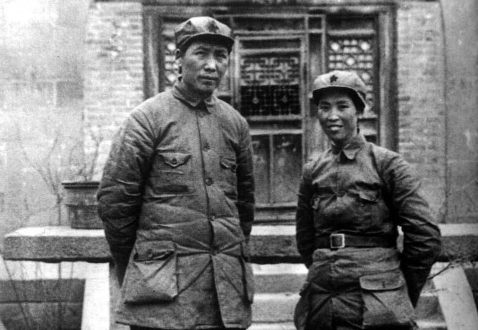
The way in which she and Mao first came together also reflected her status as an educated woman. In early 1928, Mao asked her to help him work on some manuscripts. Shortly after that she had moved into his house and shortly afterwards they celebrated their “marriage” with a large banquet. This was a mere few months after he had left his wife and children exposed to danger in Changsha.
Some commentators say she was a reluctant bride, a seventeen-year-old married to a man twice her age. It has been suggested that her consent owed more to politics and the need to buy protection than to love or sexual attraction. It has even been suggested that when Mao eventually broke out of the Ruijin Soviet and embarked on the Long March, she tried to stay. There are good reasons for believing this, but more of that later.
Whatever way you look at it, He Zizhen’s marriage to Mao brought little but bitterness and suffering. If He Zizhen had been a reluctant bride, this doesn’t seem to have extended to keeping Mao from her bed. Their first child, a girl, was born in June 1927 in a village in the mountains of Fujian province. This was at a stop during a retreat from enemy forces. Mao insisted that the baby be given away to a peasant family along with fifteen silver dollars. When they returned to the village two years later in search of the child they were told it had died.
In November 1932 she gave birth to another child, a son, and in late 1933 to another which lived only a short time. Then finally by mid-1934, under constant attack from Chiang Kai-shek’s forces, the communists began to make preparations to leave the Ruijin Soviet area and undertake the Long March to the North-West of China. Party leadership took the decision that only a limited number of women would be allowed to accompany the march. This was made up of thirty wives of top party personnel and twenty nurses and other women in service.
He Zizhen was included among the thirty leadership wives but she was forced to part with her son. The party was firm that no children could be brought along. You can imagine why she might have been reluctant to go. He Zizhen asked her sister to deliver the child to their wet nurse. They never saw their child again. It appears that Mao’s brother Zetan took the child from the wet nurse and entrusted it to one of his guards who lived in Ruijin to bring it up. Shortly afterwards Zetan was killed in battle and the secret of the child’s whereabouts died with him.
In February 1935 while on the Long March in Guizhou Province she gave birth in a straw hut in a minority area. Once again the baby, along with thirty silver dollars, was handed to a local peasant. Then while marching through north-western Sichuan, she fell victim to a KMT bombing attack. X-rays revealed seventeen pieces of shrapnel in her body. She had to make the rest of the journey on a stretcher.
In mid-December 1935 the Long March reached its destination in the hills of northern Shaanxi Province round the towns of Bao’an and Yan’an. This was loess country, loess being the friable yellow earth whose canyons cover most of northern China. People in this area live in “cave houses”, houses dug deep into the loess cliffs with elaborate carved timber and paper facades, and Mao and He Zizhen moved into one such cave. There in January 1937, Zizhen gave birth to yet another child, a girl referred to as Jiaojiao, but whose real given name was Li Min.
But it was in Yan’an where, despite, or possibly because of the rigours of the Long March, a final rift occurred between Mao and He Zizhen. He Zizhen had a notoriously bad temper. She was a Hakka, and uniquely in China, Hakka women were independent, did not bind their feet and did most of the heavy work. Domestic disputes between Mao and Zizhen became legendary in the communist society. Mao told his daughter Li Min that their disagreements often became violent to the extent that Mao would call upon his political authority and even threaten to expel her from the Party.
The problems in Yan’an began with the arrival of a Comintern agent and journalist, the American Agnes Smedley. Smedley had a long history of involvement in Comintern affairs in many parts of the world, and had been the mistress of the Soviet spymaster Richard Sorge. She arrived in Yan’an under her cover as the correspondent of the Manchester Guardian and the Frankfurter Zeitung.
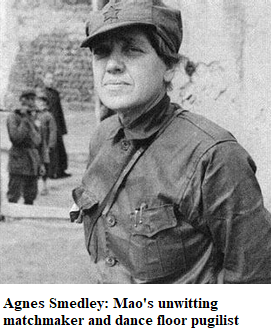 Smedley typified many left-wing Europeans and Americans of the time in that she saw her duty as being to bring enlightenment to the uncivilised of the world. In Yan’an her main shtick was women’s rights, particularly birth control, and she spent much effort on propagandising birth control amongst the peasant women of the Soviet area. Her efforts did not meet with unalloyed success. The main method of contraception which she espoused was douching, but the peasant women showed scant understanding of her message, preferring to drink the lemon-scented liquid which she had given them for that purpose.
Smedley typified many left-wing Europeans and Americans of the time in that she saw her duty as being to bring enlightenment to the uncivilised of the world. In Yan’an her main shtick was women’s rights, particularly birth control, and she spent much effort on propagandising birth control amongst the peasant women of the Soviet area. Her efforts did not meet with unalloyed success. The main method of contraception which she espoused was douching, but the peasant women showed scant understanding of her message, preferring to drink the lemon-scented liquid which she had given them for that purpose.
Smedley spoke no Chinese and relied on her translator, one Wu Lili. Wu Lili was one of the many actresses from left-wing stage and screen troupes who had made their way to Yan’an. She had studied English at a Shanghai business college and had become the main interpreter in Yan’an, including for meetings with American journalist Edgar Snow which resulted in his influential book Red Star over China. She was widely considered the beauty of Yan’an.
Now, one could never say that communists anywhere were sexually puritanical. In China, as in Moscow, marriages came and went quickly as women and men dallied and changed caves. But after the rigours of the Long March, revolutionary women tended to eschew the trappings of femininity. The revolutionary bob was the norm as a hairstyle and both sexes wore shapeless grey and navy cotton clothing. Sex? You did it but you didn’t talk about it too much. Added to this was the complication that men outnumbered women many times over.
Wu Lili wore makeup and styled her hair, which was long and black and hung over her shoulders. She had brought large amounts of cosmetics with her and she used them. And it was more than rumoured that she had become Mao’s mistress.
In her quest to bring civilisation to the seething masses of China, Smedley encouraged efforts to introduce a new form of entertainment, Western-style social dances. She and Wu Lili taught ballroom dancing at night in Yan’an’s social centre, the Catholic Church, and Wu Lili became the star of ballroom dancing.
One night after Mao and Lili had been seen holding hands and mooning on the dance floor, Zizhen snapped. She bearded them in their den, Lili’s cave, and began screaming insults and beating Mao round the head with the long handle of a torch. She then turned on Lili, calling her a “dance hall strumpet” and scratching her face, drawing blood. Agnes Smedley joined the fray; Zizhen led with the ultimate insult “Imperialist!” and hit her with the torch. Smedley returned with a punch to Zizhen’s face, blackening her eye and laying her out on the floor.
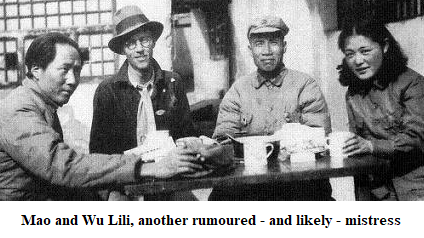 After this fracas Mao had no option but to send Lili away; this was made easier by the fact that Zhou Enlai had already decided that she was an American agent. But there was no future for Zizhen with Mao after this. In June she left Yan’an for Xi’an and then in October 1937 she went to Moscow “for treatment”.
After this fracas Mao had no option but to send Lili away; this was made easier by the fact that Zhou Enlai had already decided that she was an American agent. But there was no future for Zizhen with Mao after this. In June she left Yan’an for Xi’an and then in October 1937 she went to Moscow “for treatment”.
She was once more pregnant when she arrived in Moscow but the child died shortly after birth. Their daughter remained with Mao, but Stalin wasn’t prepared to let that happen for long. Three years later their daughter was also sent to Moscow. Zizhen finished up in a Soviet asylum purportedly suffering from schizophrenia. Chinese sources tell a different story. It seems that their daughter Li Min was suffering from pneumonia in a boarding school outside Moscow. Zizhen believed that she was being treated badly and she had a violent argument with the director of the school. He had her declared mad and sent to the asylum. We can only speculate on Mao’s role in this decision.
Meanwhile, even before Zizhen had left for Moscow, Mao was already grooming her successor. Jiang Qing was born Li Shumeng in the village of Zhucheng in Shandong Province in 1914. Her father appears to have died when she was young and she and her mother went to live in the provincial capital, Jinan, with an uncle who was supervisor of a middle school. Through contacts, he was able to get her enrolled in a school attached to the provincial normal school and there she stayed until she was fourteen under the name Li Yunhe. But her mother was destitute and wanted to sell young Yunhe into prostitution or as a concubine. Yunhe went to the police for protection and the police sent her to the newly established Shandong Provincial Experimental Dance Academy. This was in 1929. There she was trained in Beijing opera and stage plays in the Suzhou and Mandarin languages. In 1933 she left the academy and went to Qingdao, the province’s biggest and most cosmopolitan city, where she called on the former director of the academy, who was now Dean of Qingdao University. He got her a job in the university library. Like most universities in China, Qingdao was a hotbed of revolutionary activity and there young Yunhe had an affair with one Yu Qiwei, an active underground communist. It was 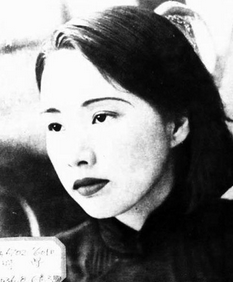 through him that she first joined the “Communist Cultural Front” of Qingdao. In February 1933 she joined the Communist Party.
through him that she first joined the “Communist Cultural Front” of Qingdao. In February 1933 she joined the Communist Party.
In 1934 she was introduced to a Shanghai movie director, Shi Dongshan, who agreed to take her to Shanghai, China’s Hollywood. There Li Yunhe (right) became Lan Ping. The communists considered propaganda to be every bit as important as guns and in the 1930s movies were the sharp end of propaganda. Accordingly the Central Committee ordered the establishment of an alliance of Chinese leftist writers, which had a motion picture group. The group had its own movie company, the Tien Tung Motion Picture Company: if you think “fake news” is a new thing, consider the fact that Tien Tung employed a group of writers to write favourable reviews of Tien Tung movies for the Shanghai newspapers. Tien Tung hired Lan Ping as a bit player on the handsome salary of twenty-five Mexican dollars a month.
She appeared in numerous films and plays, including Goddess of Freedom, Scenes of City Life, Blood on Wolf Mountain and Wang Laowu. In Ibsen’s play A Doll’s House, Jiang Qing played the role of Nora. Her performance in Blood on Wolf Mountain was highly praised (don’t forget that we’re in fake-news territory here) and her role as a shrewish termagant in Wang Laowu was considered by those in the know to be close to her own character. When I started reading about Jiang Qing’s movie career in the late 1960s, it was received wisdom that these movies had all been destroyed, but now you can watch them on YouTube.
After the Tien Tung Company was suppressed by the KMT authorities, she joined the reconvened Lian Hua company and in 1937 starred in Big Thunderstorm. She also acquired a husband, the actor Tang Na, however since she had continued her affair with Yu Qiwei and started another with her director Zhang Min, this marriage soon came to an end.
The Japanese attack on Shanghai in 1937 made movie-making there impossible. The Party organised its Shanghai actors into groups who were to travel the country propagandising against Japanese aggression. There 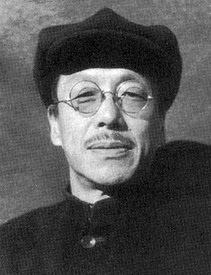 is some debate about dates here, but I think the evidence points to Jiang Qing going directly from Shanghai to Yan’an in 1937. There she came under the wing of Kang Sheng.
is some debate about dates here, but I think the evidence points to Jiang Qing going directly from Shanghai to Yan’an in 1937. There she came under the wing of Kang Sheng.
Kang Sheng (left) is possibly the most unpleasant person you are likely to meet in the history of the Chinese Republic. He was Mao’s hangman, head of the Chinese KGB, utterly ruthless, and responsible directly for countless deaths. He was a native also of Jiang Qing’s Zhucheng village and in China that sort of relationship matters even more than it does elsewhere. At the time of Jiang Qing’s arrival in Yan’an, he was head of the Lu Xun party school into which Jiang Qing was enrolled. It was also strongly rumoured that he and Jiang Qing had an affair. Whatever the truth of that, she became Kang Sheng’s protégée.
In April 1938, Mao gave a talk at the Party School. Jiang Qing sat in the front row, smiled widely at Mao and took copious notes. After the talk, she went up to him and asked for guidance. Mao invited her to visit him. Mao’s infatuation with the newly arrived actress soon became the subject of gossip around Yan’an. Many found her suspiciously bourgeois and disliked her sophisticated Shanghai ways. Some openly said she was a KMT agent. There was an intra-party struggle going on at the time between Mao and a group of Moscow-educated returnees and the Moscow faction was using Mao’s behaviour with Jiang Qing against him.
Kang had previously backed the Moscow faction, but he saw Jiang Qing’s liaison with Mao as an opportunity to ingratiate himself with Mao and gain personal power. As head of the security apparatus, he vouched for Jiang Qing, embellished her Party file, removed any material which could be used against her, threatened potential hostile witnesses and coached her on how to field the interrogators’ questions. From then on she became a party insider and in the Cultural Revolution one of China’s most powerful people.
I won’t go into Jiang Qing’s latter life here. She’s too important a character in Chinese history and deserves a full article on her own. What is most relevant to this discussion is that she married Mao in November 1938—this was after previously barging into a meeting of the top leadership and announcing, “I have good news. The Chairman and I have started living together.” She bore him one daughter, Li Na, in 1940.
From then on, many women’s names were associated with Mao. It was even rumoured that in his dotage the old imperial practice of bringing him virgins to restore his vigour was used. His personal physician has nothing to say on that account. The woman whose name was most associated with his was his nurse and secretary Zhang Yufeng. Zhang became one of the most powerful people in China. In the maelstrom of power struggles during the Cultural Revolution, what the Chairman said on any issue of policy or personality could be decisive, and Zhang Yufeng decided who would get to see the Chairman to hear the answer to the question. And when the word came down, she was the person who deciphered what the word actually was. As Mao aged his speech became slurred by Parkinson’s disease—he also had the problem that he never really learned to speak Mandarin properly—thus only Zhang Yufeng could say what he actually meant.
And in the end, in 1976, there was a final flutter of Mao’s lifelong interest in women, which we can see from pictures of the enthusiasm with which he greeted the famous beauty Imelda Marcos during her visit to China. But was it enthusiasm for Mrs Marcos’s beauty? In Chinese, Marcos is pronounced Makesi, but there is another famous Makesi. I have a sad suspicion that, in his dotage, Mao thought he was meeting the wife of Marx himself.
Ted Rule has written several articles on China for Quadrant. His article “Chiang Kai-shek: A Fighter, Not a Lover” appeared in the October 2019 issue.
 Sign In
Sign In 0 Items (
0 Items ( Search
Search










“Power is the greatest aphrodisiac.” Could this have implications for our premiers?
A fascinating essay.
With a moderate degree of irony, it could be sub-titled The Director’s Couch, attracting all the ire of MeToo.
In the picture, Mao is seen holding a Gauloise on his left side hand. Who in their right frame of mind would smoke, every lifestyle disease known to man is accelerated by smoking.
Ah, Mr Zedong do you have any interests or hobbies? The reply to the arrogant capitalist had him fuming with indignation- to which the summation of the free intellect of the powerful peasant was -SMOKE.
The communist hypocrite had a habitual liking for the greatest known example of capitalism , the cigarette.
To lift a quote from Paul Kengor’s book- The Devil and Karl Marx under the title, ‘Of Prosecuting the War’ . Alexander Yakovlev and his thought on Lenin,” His actions against religion and the Church are astonishing in their diabolical ferocity and immorality”.
Mao is, to put it simply , the Chinese equivalent of the devil incarnate.
None of us are perfect, but for a man ,in this case Mao, to violate the sanctity and the beautiful God given nature of Woman / Women, is actually an act of violence that desecrates not only a woman’s physical nature but her spiritual being as well- akin to a lack of respect- this wrecking ,or if you like act of violence is spawned from the seeds of hatred – not the sacred.
Interesting how Mao went to his maker with a disease of the ‘central ‘nervous system.
With the very early deaths of his spawn and his own dribbling death it looks like congenital syphilis, unlike that of Lenin whose deranged death was from advanced sodomitic syphilis.
The official cause of Mao’s death was complications related to Parkinson’s Disease. Who knows? Mao’s health would be a study on its own. What has always fascinated me, in 1966 when Mao reappeared in public life after his post-Lushan meeting political eclipse, the propaganda always described him as “in radiant good health”. Which begs the question, how had he been before, or even was this true. His personal doctor, Li Zhisui is suspiciously silent on this question as he is on many other matters. Matters for future research. What we do know, from reading transcripts of meetings with world leaders in his final years, is that what he said rarely made any rational sense. His final meeting (with Piggy Muldoon!) was totally incoherent. Why did so few people notice this?